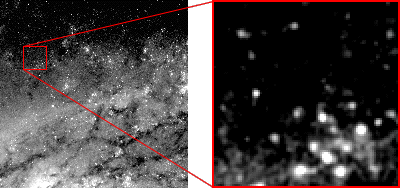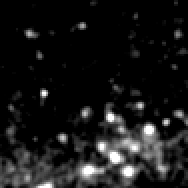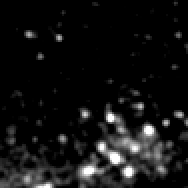
As mentioned in the last section, we'll only look at the WF4 images of M100 in our search for Cepheids. Let's zoom in on a region of WF4 to a scale where individual stars can be distinguished. We'll first examine a region where there are no known Cepheids.

The left image above is a full image of WF4 taken on May 4, 1994. The red box on the left denotes a region 1/64 the area of the full image. On the right is that same region magnified by a factor of 8. On this zoomed scale, individual stars are clearly discernible.
Before we go any further, one technical note should be made. The image on the right has been mathematically smoothed. When you looked at magnified views of PC1, WF2, WF3 or WF4 in the previous section, the individual square pixels in each chip were clearly visible. The smoothing process makes the stars look a bit larger and rounder, and subdues the inherent background "noise" in the images. This will make it a bit easier to identify Cepheids. One of the most appealing aspects of digital imaging is the ability to process the images to suit the need at hand.
Now that we've found a scale where we can easily see stars, how do we look for brightness variations? An obvious first method would be to place images from different epochs side by side. Let's look at the same zoomed region shown above at two different epochs. If the two images below do not appear side by side, expand the width of your Netscape window until they are side by side.
The image on the left was taken May 4, 1994. The image on the right was taken two days later, on May 6.


Try to discern some differences between the two images. Some may be easy to note, others more difficult.
Sure, you can see changes, but there's a much easier way to do it; we can blink the two images. Below you see the May 4 image being blinked with the May 6 image. Now the changes between the frames seem to jump out at you!

Tip: when looking for variations between blinked images, sometimes it helpful to place the cursor at a place of interest to guide your eye.
Many variations are apparent between these images. What causes each of the variations you see? We'll have to blink more than 2 images to answer that better.
Back to The HST images of M100 used for the Cepheid hunt
Back to the table of contents